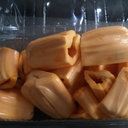Evaluation of hepatic function with (99m)Tc-galactosylated serum albumin scintigraphy in patients with malaria: comparison with (99m)Tc-colloid scintigraphy and liver ultrasonography.
Ključne riječi
Sažetak
OBJECTIVE
Malarial parasites injected by the mosquito rapidly target hepatocytes, and hepatomegaly is commonly observed during the progress of the disease in malaria patients. To evaluate the degree of hepatic damage and functional status of hepatocytes in malaria patients, we performed liver scintigraphy using (99m)Tc-galactosylated serum albumin (GSA) prospectively and the findings were compared with those of (99m)Tc-colloid scintigraphy, ultrasonography and clinical results in the same subject.
METHODS
Eight malaria patients (all male, mean age 22 years) confirmed to be infected with Plasmodium vivax underwent (99m)Tc-GSA liver scintigraphy, followed by liver ultrasonography and (99m)Tc-colloid scintigraphy using phytate within 3 days. For hepatocyte scintigraphy, anterior images of cardiac blood-pool and liver were continuously acquired for 30 min after injection of 185 MBq (99m)Tc-GSA (3 mg). In addition to visual interpretation of the images, quantitative measurement of hepatic function was performed with several functional parameters, such as hepatic uptake index (LHL15), blood clearance index (HH15) and modified receptor index (LHL/HH) calculated from the radioactivity of the liver and heart. (99m)Tc-colloid images were assessed and graded visually. Severity of hepatic dysfunction or reticuloendothelial system activation was classified as normal, mild, moderate and severe on GSA or colloid images.
RESULTS
Hepatomegaly was observed in five and splenomegaly in seven of the eight patients. Serum levels of transaminase and alkaline phosphatase were mildly elevated in two. Visual assessment of GSA scintigraphy revealed normal findings in all subjects, except for mild increases in size. The mean values of LHL15, HH15 and LHL/HH were 0.928+/-0.014, 0.537+/-0.031 and 1.732+/-0.106, respectively. They were graded as normal in five, and near-normal to mild dysfunction in three subjects. In contrast, (99m)Tc-colloid scintigraphy revealed abnormal findings in all of the subjects, and graded as moderate in three or severe reticuloendothelial system activation in five subjects. Liver ultrasonographic findings were normal for all subjects except mild hepatomegaly.
CONCLUSIONS
Malaria-induced injury of the hepatocyte is likely to be minimal whereas hepatomegaly is commonly seen during disease process. This suggests that hepatic damage in malarial infection is mainly due to involvement of the reticuloendothelial system. (99m)Tc-GSA scintigraphy can be used in differentiating hepatocellular damage from reticuloendothelial system involvement in patients with infectious disease showing hepatomegaly.


